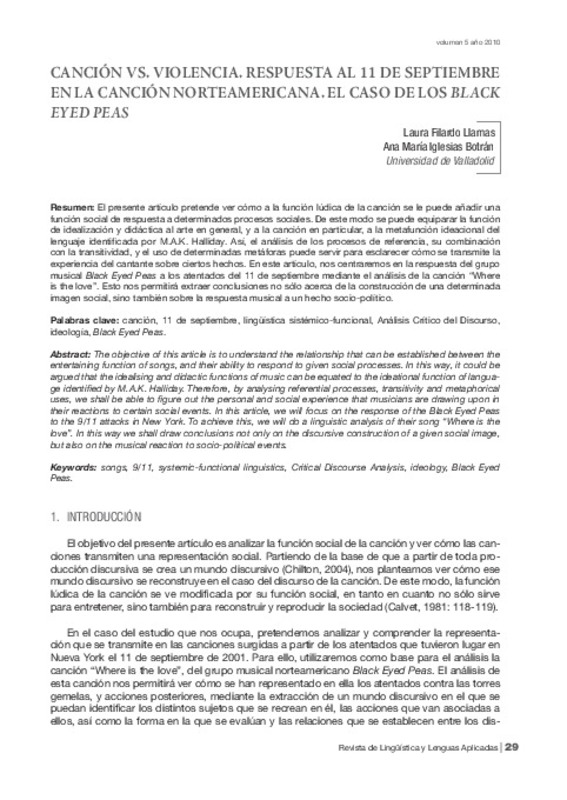JavaScript is disabled for your browser. Some features of this site may not work without it.
Buscar en RiuNet
Listar
Mi cuenta
Estadísticas
Ayuda RiuNet
Admin. UPV
CANCIÓN VS VIOLENCIA. RESPUESTA AL 11 DE SEPTIEMBRE EN LA CANCIÓN NORTEAMERICANA. EL CASO DE LOS BLACK EYED PEAS
Mostrar el registro sencillo del ítem
Ficheros en el ítem
| dc.contributor.author | Filardo Llamas, Laura
|
|
| dc.contributor.author | Iglesias Botrán, Ana María
|
|
| dc.date.accessioned | 2011-04-04T09:03:58Z | |
| dc.date.available | 2011-04-04T09:03:58Z | |
| dc.date.issued | 2010 | |
| dc.identifier.issn | 1886-2438 | |
| dc.identifier.uri | http://hdl.handle.net/10251/10661 | |
| dc.description.abstract | [EN] The objective of this article is to understand the relationship that can be established between the entertaining function of songs, and their ability to respond to given social processes. In this way, it could be argued that the idealising and didactic functions of music can be equated to the ideational function of language identifi ed by M.A.K. Halliday. Therefore, by analysing referential processes, transitivity and metaphorical uses, we shall be able to fi gure out the personal and social experience that musicians are drawing upon in their reactions to certain social events. In this article, we will focus on the response of the Black Eyed Peas to the 9/11 attacks in New York. To achieve this, we will do a linguistic analysis of their song “Where is the love”. In this way we shall draw conclusions not only on the discursive construction of a given social image, but also on the musical reaction to socio-political events | es_ES |
| dc.description.abstract | [ES] El presente artículo pretende ver cómo a la función lúdica de la canción se le puede añadir una función social de respuesta a determinados procesos sociales. De este modo se puede equiparar la función de idealización y didáctica al arte en general, y a la canción en particular, a la metafunción ideacional del lenguaje identifi cada por M.A.K. Halliday. Así, el análisis de los procesos de referencia, su combinación con la transitividad, y el uso de determinadas metáforas puede servir para esclarecer cómo se transmite la experiencia del cantante sobre ciertos hechos. En este artículo, nos centraremos en la respuesta del grupo musical Black Eyed Peas a los atentados del 11 de septiembre mediante el análisis de la canción "Where is the love". Esto nos permitirá extraer conclusiones no sólo acerca de la construcción de una determinada imagen social, sino también sobre la respuesta musical a un hecho socio-político. | |
| dc.language | Español | es_ES |
| dc.publisher | Editorial Universitat Politècnica de València | es_ES |
| dc.relation.ispartof | Revista de Lingüística y Lenguas Aplicadas | |
| dc.rights | Reserva de todos los derechos | es_ES |
| dc.subject | 11-S | es_ES |
| dc.subject | Lingüística sistémico funcional | es_ES |
| dc.subject | Análisis crítico del discurso | es_ES |
| dc.subject | Black eyed peas | es_ES |
| dc.title | CANCIÓN VS VIOLENCIA. RESPUESTA AL 11 DE SEPTIEMBRE EN LA CANCIÓN NORTEAMERICANA. EL CASO DE LOS BLACK EYED PEAS | es_ES |
| dc.type | Artículo | es_ES |
| dc.date.updated | 2011-04-01T13:12:31Z | |
| dc.identifier.doi | 10.4995/rlyla.2010.751 | |
| dc.rights.accessRights | Abierto | es_ES |
| dc.description.bibliographicCitation | Filardo Llamas, L.; Iglesias Botrán, AM. (2010). CANCIÓN VS VIOLENCIA. RESPUESTA AL 11 DE SEPTIEMBRE EN LA CANCIÓN NORTEAMERICANA. EL CASO DE LOS BLACK EYED PEAS. Revista de Lingüística y Lenguas Aplicadas. 5:29-40. https://doi.org/10.4995/rlyla.2010.751 | es_ES |
| dc.description.accrualMethod | SWORD | es_ES |
| dc.relation.publisherversion | http://doi.org/10.4995/rlyla.2010.751 | |
| dc.description.upvformatpinicio | 29 | |
| dc.description.upvformatpfin | 40 | |
| dc.description.volume | 5 | |
| dc.identifier.eissn | 1886-6298 | es_ES |








